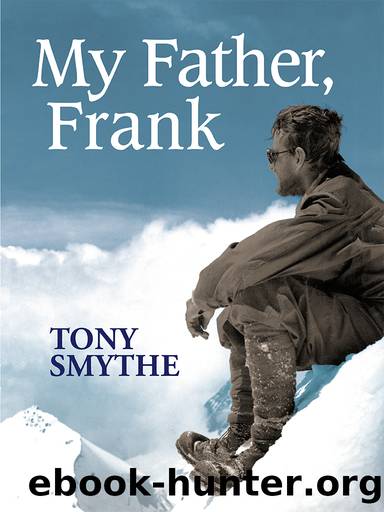My Father, Frank by Tony Smythe

Author:Tony Smythe
Language: eng
Format: epub
Publisher: Vertebrate Publishing
Published: 2013-10-18T00:00:00+00:00
His book, Kamet Conquered was published in August 1932. As a story it lacked the drama and spice of Kangchenjunga but the reviewers were generally appreciative, apart from one writing anonymously in the RGSâs Geographical Journal, who saw Frankâs remarks about the distressed and frostbitten Lewa as âunfeeling and ungenerous.â This critic also disliked Garhwali villages being described as filthy hovels and valley air âreeking of disease and death.â Smytheâs style was âlaboured,â and as a traveller he was ânot at home in the East.â
Frank was shocked and angry. He wrote to the President, a four-page letter that swung between defence of his own conduct in India and bitter resentment of the anonymous reviewer who had âoverstepped the limits of legitimate criticismâ and made a âpersonal and personally damaging attack.â [5] The Society had allowed an unsigned attack to be made upon one of its Fellows ⦠The reader would infer that he was not a fit and proper person to be entrusted with the conduct of an expedition in the Himalayas ⦠The good impression his party had left behind could be confirmed ⦠No one had greater admiration for their gallant Sirdar Lewa than he ⦠The reviewer had gone out of his way to attribute to him a meanness and uncharitableness which were most damaging and distressing â¦
The letter landed on the desk of the incoming President, Sir Percy Cox. âLegacy from my predecessor,â he scrawled on it. âRecord, I suppose.â However before the letter disappeared it was passed to a Council member, Tom Longstaff for his comments.
Longstaff was a highly respected figure in British mountaineering. At the age of 57 his record was outstanding: 20 visits to the Alps and almost as many further afield. More than mere enthusiasm was needed for an explorer; âqualify yourselfâ was his stern advice. He was wealthy with private means, but before his first trip to the Himalayas in 1905 he had gained a medical degree, become a first-rate naturalist, and had a working knowledge of the languages he would need. He travelled light, with just one or two companions and a few porters. In 1907 he climbed Trisul, 23,360 feet â the highest summit then reached, a record unsurpassed for 21 years. He went to Everest in 1922 as a doctor and naturalist. He won the Founderâs Medal of the RGS, the highest honour for an explorer, awarded to very few.
In 1929 Longstaff had written an encouraging review of Climbs and Ski Runs. He had attended Frankâs Kamet lecture at the RGS and had come to the lectern afterwards to congratulate him. Frank had apparently been acceptable to Longstaff, who normally disliked on principal anyone making money from mountaineering. According to his daughter, Sylvia he didnât think mountains should be written about, and wrote almost nothing himself other than diaries until he published a single volume of memoirs later in life.[6] Thereâs no evidence that he held adverse opinions about Frankâs book on Kangchenjunga, which was reviewed well in the Geographical Journal.
Download
This site does not store any files on its server. We only index and link to content provided by other sites. Please contact the content providers to delete copyright contents if any and email us, we'll remove relevant links or contents immediately.
I Have Something to Say by John Bowe(3467)
Einstein: His Life and Universe by Walter Isaacson(1969)
What Happened to You? by Oprah Winfrey(1733)
Doesn't Hurt to Ask by Trey Gowdy(1606)
Solutions and Other Problems by Allie Brosh(1298)
American Dreams by Unknown(1238)
Disloyal: A Memoir by Michael Cohen(1209)
The Silent Cry by Cathy Glass(1096)
Talk of the Ton by unknow(1018)
Infinite Circle by Bernie Glassman(1017)
Don't Call it a Cult by Sarah Berman(1011)
Group by Christie Tate(997)
Home for the Soul by Sara Bird(991)
Before & Laughter by Jimmy Carr(849)
Severed by John Gilmore(835)
Total F*cking Godhead by Corbin Reiff(824)
Ghosts by Dolly Alderton(819)
The Book of Hope by Jane Goodall(810)
Searching for Family and Traditions at the French Table by Carole Bumpus(788)
